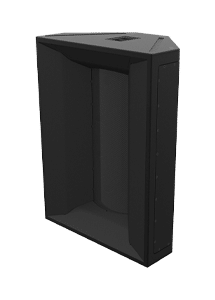Hi,
Short version:
Want to build 2-way, 2 drivers total Multiple Entry Horn type speaker. Schematics is this:

It will be used commercially not for personal use and I will get reward for building them.
Long version:
There is a request to build some heavy-duty speakers on cheap and most likely in the way they will be used it matters very little what type they will be: the simplest way could be to build some Econowave type box, or reasonably sized BR or any other "classic" type boxes and call it a day, but my brain is itchy as this is an opportunity to learn something new. I see there
There are 2 most widely discussed patents related to this: https://patents.google.com/patent/US8284976B2/en?inventor=thomas+J+danley&oq=thomas+J+danley and expired one https://patents.google.com/patent/US6411718B1/en?oq=US6411718B1 but there are also many more commercial speakers with this principle made not by the inventor related company, so it get interesting: either they have commercial relationship or the patent is kinda... how to say... about nothing.
The questions:
-Can I build commercially such speaker?
-Will it change if there are 1,2,4 or another amount of low frequency (LF) speakers?
p.s. Like most of the people because of the specific language used in many of recent patents texts I don't understand much what is written there
Short version:
Want to build 2-way, 2 drivers total Multiple Entry Horn type speaker. Schematics is this:
It will be used commercially not for personal use and I will get reward for building them.
Long version:
There is a request to build some heavy-duty speakers on cheap and most likely in the way they will be used it matters very little what type they will be: the simplest way could be to build some Econowave type box, or reasonably sized BR or any other "classic" type boxes and call it a day, but my brain is itchy as this is an opportunity to learn something new. I see there
There are 2 most widely discussed patents related to this: https://patents.google.com/patent/US8284976B2/en?inventor=thomas+J+danley&oq=thomas+J+danley and expired one https://patents.google.com/patent/US6411718B1/en?oq=US6411718B1 but there are also many more commercial speakers with this principle made not by the inventor related company, so it get interesting: either they have commercial relationship or the patent is kinda... how to say... about nothing.
The questions:
-Can I build commercially such speaker?
-Will it change if there are 1,2,4 or another amount of low frequency (LF) speakers?
p.s. Like most of the people because of the specific language used in many of recent patents texts I don't understand much what is written there

 . ChatGPT said that it didn’t know the patent specifics, and gave up, but at least was friendly
. ChatGPT said that it didn’t know the patent specifics, and gave up, but at least was friendly 